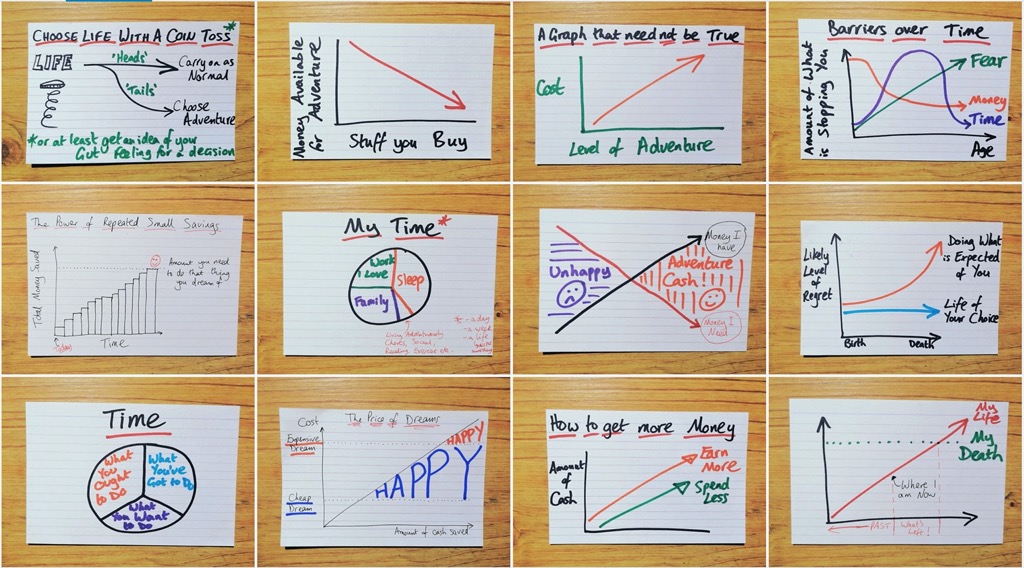
Heading up the west face of Box Hill in Surrey, running in between the zig zag road and the Burford slope is a track, half made and half mud called the ‘pig track’. Not being a native to Surrey, I had heard the track referred to as such, and as is the way of fitting in, I adopted the name and never asked why it was so called. Privately I wondered about the history of the name. I assumed it was an old farm track for herding animals – there are a number of ancient paths that criss-cross Box Hill. It was not an unreasonable assumption, although the escarpment these days is more usually home to fluffy black and white belted Galloway cattle with ne’er a pig in sight.
Then, very recently, I have been researching a phenomenon called ‘Psychogeography’ for another project and learned the following. A pig track is a common name for a ‘desire line’, and a desire line is a path created as a consequence of use caused by animal or human footfall. The path usually represents the shortest or most easily navigated route between origin and destination. Desire paths are often a rebellion agains the will of the planner, as creators deviate from the path designed for them.
So it turned out that this was not the first time I had heard of pig tracks – although in my defence I had never heard them referred to as such. My old geography tutor used to say that a sensible urban planner would delay setting official paths until the end users had time to explore the space. As people would naturally take the most advantageous routes, plotting paths that planners could then formalise in the more permanent way. When it comes to travel, the path of least resistance appears to be the most favourable.
But then I wondered if the concept of ‘least resistance’ is applicable elsewhere in life, so I had a scout round all the usual media channels. And well, it’s every where. We lay our own pig tracks everywhere we go, both physically and metaphorically. They’re called habits.
In a recent blog post I talked about the problem of waiting for inspiration to drive you out the door. The problem with inspiration, is that the couch is mighty comfortable, and it’s dark and cold outside and there’s an important television program you want to catch up on and there’s always another reason not to do what you would like to do. The trick is to remove enough barriers to get your shoes on.

You don’t need to do any of this on your own. There is a lot of help out there for people who want to realise dreams – no matter what they are. But in my opinion, the best two to start with are:
James Clear has written a wonderful book on how to break destructive habits and build constructive ones. Start here to get the basics.
Adventurer Alastair Humphreys has devoted an entire website to help you remove the barriers to allow you to take the first step.
Building habits is repetitive but not difficult. You just need to be consistent and improve by 1% each time. Take the path, see how it feels, it takes a couple of weeks to trample the grass down, if it works then great, keep ploughing. If it doesn’t then identify the barrier and either move it or go round it. Make your own personal pig track.
I’m so glad to hear the phrase ‘desire track’ as just the other day I was trying to think of the name of a path that wasn’t planned but created through use as the shortest or easiest path. I tried looking it up but didn’t find the answer so thank-you!
LikeLiked by 1 person
You are welcome 😂. It’s good to see the surveillance is working well 👀
LikeLiked by 1 person
🤣🤣🤣 there was a track I used to use all the time down south that was a desire track and every time I used it it annoyed me because I knew it had a name and I didn’t know what it was 😆 I was reminded recently when I used another one!! You’ve saved me from more mental torture 😉
LikeLiked by 1 person
Invoice is in the post… 🤣
LikeLiked by 1 person
👀😂
LikeLike
It is a pig of a track to run down as rough and rocky, I remember when The Three Molehills was diverted down there. Then again changing directions and making new tracks can be rocky roads and some lead to dead ends but when you get to the end of the track sometimes a huge sense of acheivement and pride and a reinforcement you want to do it again and so new tracks are laid.
LikeLike